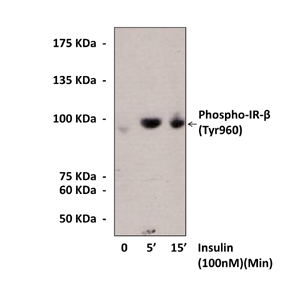Anti-Phospho Insulin Receptor-β: Rabbit Polyclonal Insulin Receptor-beta Phospho-Tyr960 Antibody |
 |
BACKGROUND Insulin receptor is a transmembrane receptor that is activated by insulin. It belongs to the large class of tyrosine kinase receptors. Two alpha subunits and two beta subunits make up the insulin receptor. The beta subunits pass through the cellular membrane and are linked by disulfide bonds.1 Insulin receptor functions as an enzyme that transfers phosphate groups from ATP to tyrosine residues on intracellular target proteins. Binding of insulin to the alpha subunits causes the beta subunits to phosphorylate themselves (autophosphorylation), thus activating the catalytic activity of the receptor. The activated receptor then phosphorylates a number of intracellular proteins, which in turn alters their activity, thereby generating a biological response.2
Several intracellular proteins have been identified as phosphorylation substrates for the insulin receptor, the best-studied of which is insulin receptor substrate 1 or IRS-1. The juxtamembrane phosphorylation site Tyr960 within the insulin receptor cytoplasmic domain is an essential determinant for the tyrosine phosphorylation of IRS-1.5 When IRS-1 is activated by phosphorylation, it serves as a type of docking center for recruitment and activation of other enzymes that ultimately mediate insulin's effects, including activation of PI-3-kinase and MAP kinase pathways.3,4
Several intracellular proteins have been identified as phosphorylation substrates for the insulin receptor, the best-studied of which is insulin receptor substrate 1 or IRS-1. The juxtamembrane phosphorylation site Tyr960 within the insulin receptor cytoplasmic domain is an essential determinant for the tyrosine phosphorylation of IRS-1.5 When IRS-1 is activated by phosphorylation, it serves as a type of docking center for recruitment and activation of other enzymes that ultimately mediate insulin's effects, including activation of PI-3-kinase and MAP kinase pathways.3,4
REFERENCES
1. Youngren, J.F.: Cell Mol Life Sci. 64:873, 2007
2. Backer, J.M. et al. J Cell Biol.118:831, 1992
3. Sesti, G. : Best Pract Res Clin Endocrinol Metab. 20:665, 2006
4. Gual, P. et al. : Biochimie 87:99, 2005
5. Backer, J.M. et al. J Cell Biol. 118:831, 1992
2. Backer, J.M. et al. J Cell Biol.118:831, 1992
3. Sesti, G. : Best Pract Res Clin Endocrinol Metab. 20:665, 2006
4. Gual, P. et al. : Biochimie 87:99, 2005
5. Backer, J.M. et al. J Cell Biol. 118:831, 1992
Products are for research use only. They are not intended for human, animal, or diagnostic applications.
Параметры
Cat.No.: | CB4378 |
Antigen: | Synthetic peptide containing human insulin receptor beta sequence (854-966) which includes phosphorylated Tyr960 |
Isotype: | rabbit polyclonal IgG |
Species & predicted species cross- reactivity ( ): | Human, Mouse, Rat |
Applications & Suggested starting dilutions: | WB 1:1000 IP n/d IHC (Paraffin) n/d ICC n/d FACS n/d |
Predicted Molecular Weight of protein: | 97 kDa |
Specificity/Sensitivity: | Anti-Phospho-Insulin Receptor (Tyr960) specifically detects endogenous levels of phosphorylated insulin receptor-beta protein. This antibody does not cross-react with other IR-family members. |
Storage: | Store at -20°C, 4°C for frequent use. Avoid repeated freeze-thaw cycles. |
*Optimal working dilutions must be determined by end user.
Информация представлена исключительно в ознакомительных целях и ни при каких условиях не является публичной офертой








